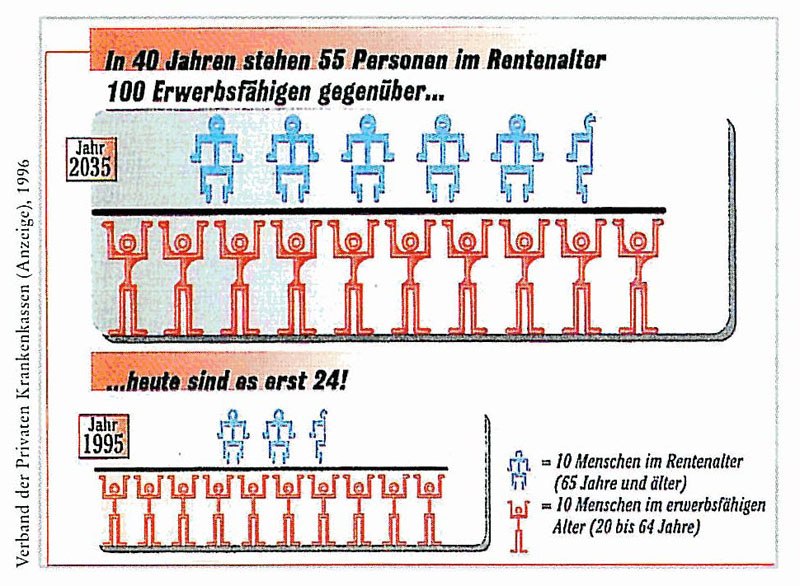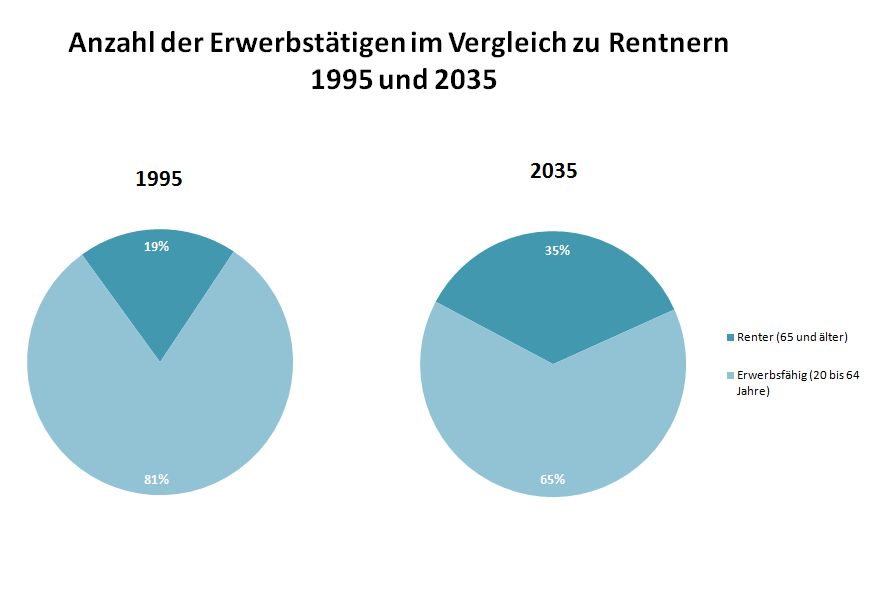Teaching:TUW - UE InfoVis WS 2007/08 - Gruppe 08 - Aufgabe 3
Poor Graphic
 Vergleich: Personen im Rentenalter & Erwerbsfähige
Vergleich: Personen im Rentenalter & Erwerbsfähige
Links
Problems with the Existing Graphic
The following problems where found when taking into account visualization prinicples (Data-Ink-Ratio, Visual Clutter, ...).
- The exact number of people are difficult to determine, especially when trying to count the human figures. Each figure is visually representing a number of people which is explained elsewhere in the diagram.
- Unimportant text ("In 40 Jahren stehen 55 Personen im Rentenalter ..." and "... heute sind es erst 24!") - it seems to be a head line - is highlighted while important ones (such as the one on the left) are not.
- The head line does not actually explain what the diagram is about. This important information can only be determined by looking at the actual picutres and reading the text between the picture. The diagram is therefore very difficult to read at a glance.
- Only part of the head line has a background color.
- The 'head line' is long and therefore difficult to read.
- at first glance the picture looks like two mathematical divisions.
- The human figures don't look like what they represent, they arn't symbolic for their respective representations, but they could. It would be possible to show a figure which look like an old man or woman to represent the pensionists and young figures which could look like business people to represent the working people. Other symbolic representations could be used but even these would not help a reader to understand the actual data.
- Compareable data within the years should be next to one another, in this case the blue figures are above the red figures.
- The figures are centered and so it is more difficult to compare the data.
- It would be easier to compare the data if there would be data like numbers next to the figures instead of the legend. This way the reader wouldnt have to link the numbers in the legend to the actual picture but would see at first glance which number belongs to what.
- It is not possible to find out of witch country or area the data referent.
- The blue and red figures dont have the same size.
- The two graphics 1995 and 2035 represent similar data but have different sizes.
- Different background colors are used for the graphics
- The graphics are not within cronological order, 1995 comes before 2035.
- The Legend is difficult to read, it could for example be framed.
- One could think the legend belongs to the small graphic at the bottom instead of the whole diagram
-> Due to this the diagram is very difficult to understand
Improved Graphic
Description of Changes as well as Reasoning
The following changes were made to improve the problems initially found the first diagram.
- Unneccessary data such as the 25 and 100 was removed. The exact numbers do not help the reader understand the data as this is percentage data anyway.
- Percentage numbers were added, these have more meaning than the numbers used in the initial diagram.
Kernaussage ist aber, wie viele Rentner von wie vielen Arbeitnehmern zu erhalten sind (Anzahl => absolute Zahlen).
Eure Aussage hier ist: 65% Erwerbstätige (65 % wovon? Erwerbsfähige Bevölkerung? Wohnbevölkerung? ...)
müssen 35% Rentner (35% wovon? Wohnbevölkerung? ...) erhalten.
- The charts have the same size, this allows you to compare the charts easily.
Pie Charts sind zu vermeiden, da schwieriger zu interpretieren als z.B. Balkendiagramme (vgl. S. Few).
- The background coloring was removed as this had no purpose and increased visual clutter.
- Colors were chosen that have a different brightness to allow color blind viewing and black and white printing.
- Coherent data is now grouped by the pie charts.
- sequence the data - the data is now sequenced chronologically from left to right to meet the expectations of the people.
- rank the data - The data was ranked, the smaller key group "rentner" are at the top, while the "erwerbsfaehige" are at the bottom.
Ihr schreibt in der Legende Erwerbsfähige und im Titel Erwerbstätige. Letztere sind nur eine Teilmenge von den Erwerbsfähigen!
